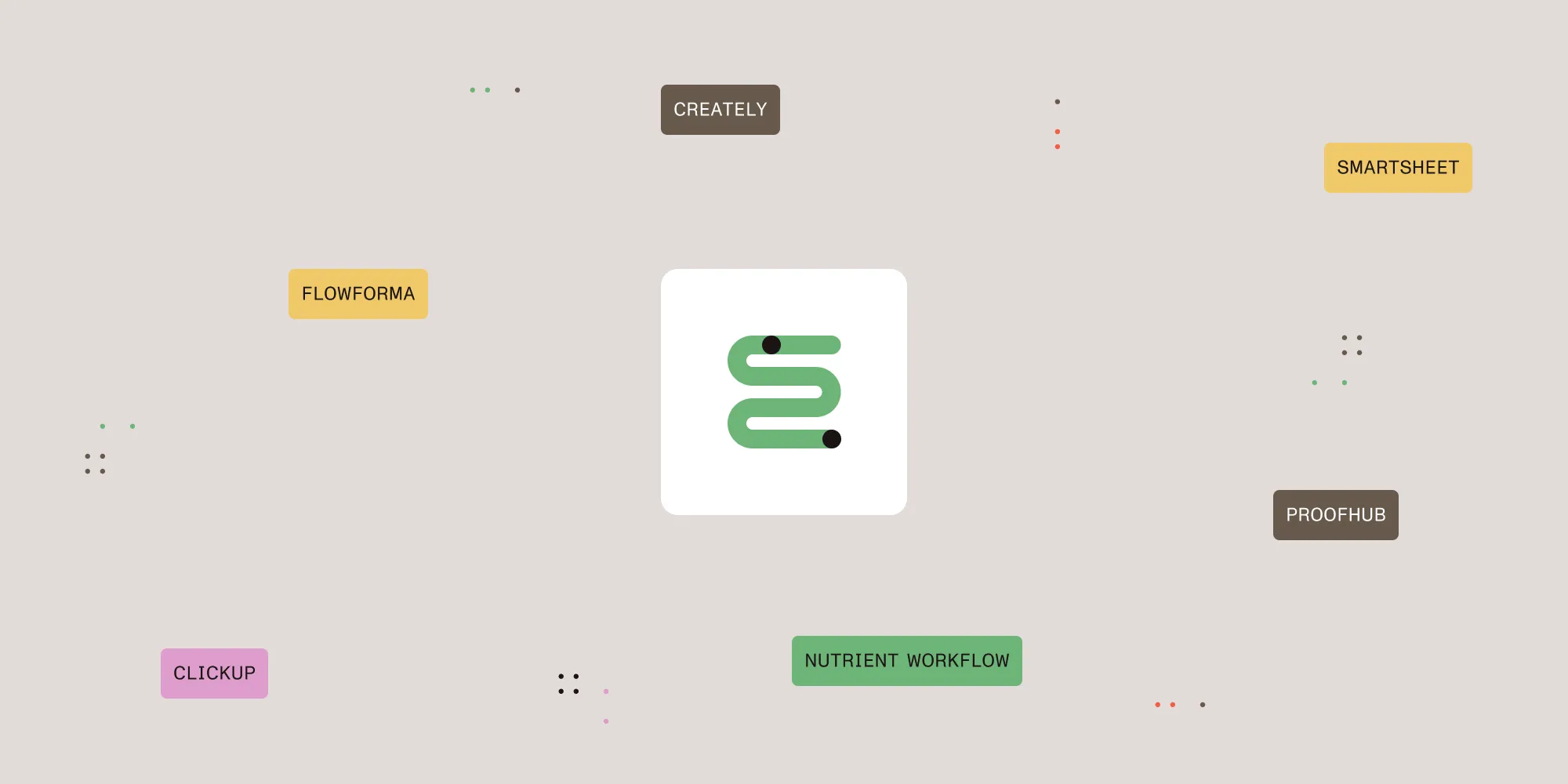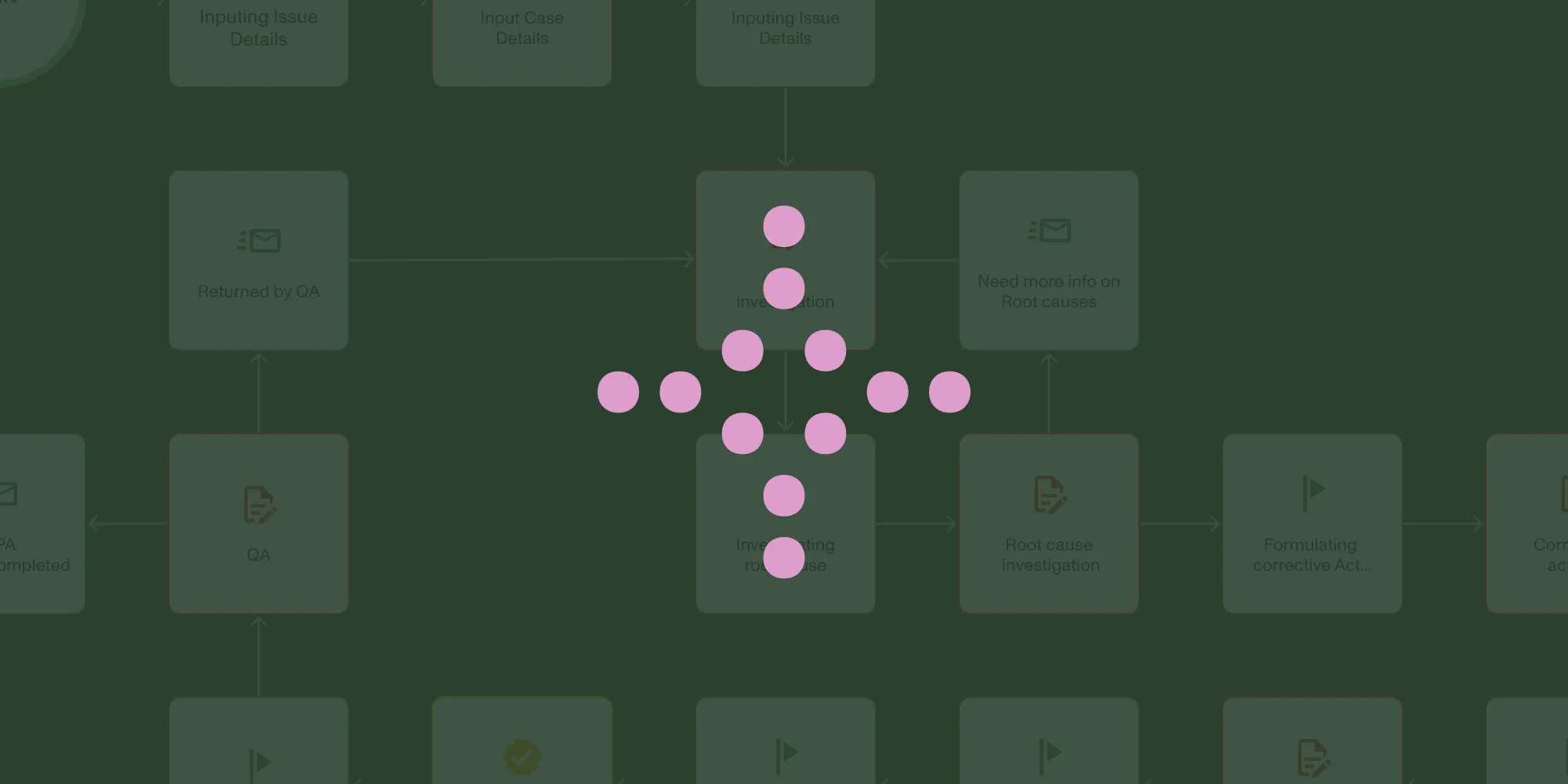15 process map examples: Complete guide (2025)
Table of contents

- Explore 15 real-world process map examples across healthcare, manufacturing, IT, finance, and more
- Read a complete comparison of tools and when to use each process mapping method
Whether it’s a small startup or a worldwide enterprise, every organization needs established business processes to operate effectively. However, if you don’t clearly understand how your methods work, it’ll be hard to figure out where things are going wrong and where you can improve. For that reason, investing in business process mapping and workflow automation software is critical to keeping up with the intricacies of various workflows that support your organization.
What is process mapping?
A business process map outlines the functions required to complete a process. For example, your HR department may have process map examples that cover employee onboarding workflows and ensure proper documentation completion. These business process map examples serve as visual frameworks that demonstrate how core functions operate within your organization.
Similarly, your accounting department may have specific workflow process maps for invoice processing and accounts payable management that cover every step — from invoice receipt to payment completion — in their accounting systems.
Having business process maps in place benefits your company in many ways, including:
- Removing any confusion about the state of your current business processes
- Allowing the department to follow a consistent blueprint for getting things done
- Helping you spot redundancies in different process steps
- Facilitating communications between business areas
- Helping you remain in compliance with the legislation applicable to your industry
There are several types of process maps, each with a unique view or application. Most business analysts start with a high-level process map and get more granular during interviews with each team member. They also use mapping tools to version and track their process maps over time to provide historical context. This is especially helpful with complex processes that need to show a high level of detail and identify areas across the organization that are involved.
15 process map examples
The process map examples below demonstrate how different visualization techniques can improve workflow efficiency across your organization. Each process map type serves specific purposes and complexity levels. But before sharing, the following sections will provide an overview of important terminology.
Activity/process
An activity or process represents a step or an activity within a process. A rectangle shape typically represents it.
Flow
The flow shape (sometimes called a process mapping symbol) is typically a line with an arrow on the end. A flow highlights the sequence of execution within a process for the viewer.
Event
An event is what starts, changes, or finishes a process. The events you might want to make visible include errors, messages, cancellations, or links. Events are represented by a circle that contains other symbols, depending on the event type.
Decision
The decision shape, represented by a diamond, indicates that the process must decide moving forward. It can be a binary yes/no decision, or something more complex with multiple choices, like a case statement in a computer program. You should try and capture all options that might impact the flow of a process.
These symbols form the foundation of all process map examples and ensure consistent communication across teams.
1. Flowchart process maps
Flowcharts are the most basic type of process flow. They contain symbols that outline the flow of steps within a process in sequential order. One of the biggest benefits of flowcharts is that you can adapt them to fit pretty much any function, like manufacturing, administration, or even project planning.
The best time to use a flowchart is when you want to provide an easy-to-understand example of how a process works. Flowcharts make spotting where you want to change or improve processes easy. In addition, it’s easier for non-technical users to understand flowcharts versus other business mapping examples.
When creating a flowchart, you should:
- Focus on making the process transparent versus making it look perfect.
- Capture the key personnel involved in a process, like customers and vendors.
- Get the input of individuals involved in completing a process within the business.
2. Swimlane process maps
Swimlane process maps are similar to flowcharts, in that they visually map out the steps of a process. The most significant difference between the two is that swimlane maps line up in lanes that let the viewer know who’s responsible for completing each step, like a department or automation process.
Here’s what to keep in mind when putting together a swimlane process map:
- Where are you getting your information from?
- Is there anything that might interrupt the swimlane flow?
- Does a task need to be assigned to a different person, department, or process?
- Will you need to wait for a decision from someone else before moving to the next step?
- Will the process require data input to keep the process going?
- Will you need to transform the input to a different format?
3. SIPOC process maps
The SIPOC process map is used to outline the intent of a process, along with the key players involved. The acronym SIPOC stands for:
- Supplier — The person or organization providing input to the process.
- Input — The resource that the supplier adds to the process.
- Process — The series of steps involved in converting input into output.
- Output — The resource produced by the process.
- Customer — The person or entity that receives the output.
SIPOC process maps typically consist of six to eight total steps. It’s an ideal tool for project managers who must provide a high-level view of the functions involved in a process. A SIPOC diagram should convey:
- The start and end of the process
- Those affected by the process
- What goes into the process
- The steps involved in completing the process
Creating a SIPOC business process map shows stakeholders the information they need about each step and any dependencies.
4. Value stream maps
A value stream map (VSM) is a detailed flowchart that documents the individual steps within a process, along with the information flow and related data inputs. It may be easier to think of it as a more detailed SIPOC process map. VSMs are useful when you need to show how you can add value to a current process by making functional changes.
VSMs are great for locating and eliminating redundant steps within a business process. For example, you may want to create a VSM of a process’s current state, and then create a future state VSM that shows how it would work with your proposed improvements.
5. Customer journey maps
Customer journey maps visualize the complete experience a customer has with your organization. These process map examples track every touchpoint — from awareness to post-purchase support — making them essential for e-commerce and service businesses.
Key components of customer journey process maps include:
- Customer actions and decisions at each stage
- Emotional states and pain points
- Channels and touchpoints used
- Opportunities for improvement
6. Service blueprint process maps
Service blueprints extend customer journey maps by adding internal processes. These process map examples show both customer-facing interactions and behind-the-scenes activities that support service delivery.
Service blueprints are ideal for:
- Restaurant service delivery optimization
- Healthcare patient experience improvement
- Banking and financial services
- Hotel and hospitality operations
7. Cross-functional process maps
Cross-functional maps show how processes flow between different departments or teams. These workflow process maps are crucial for product launches, project management, and organizational change initiatives.
Benefits include:
- Clear accountability across departments
- Identification of handoff points
- Communication improvement between teams
- Bottleneck identification and resolution
8. Decision tree process maps
Decision trees map out complex decision-making processes with multiple paths and outcomes. These process map examples are perfect for customer support escalation, troubleshooting procedures, and policy compliance.
Use decision trees when:
- Multiple decision points exist in a process
- Different outcomes require different actions
- Training teams on complex procedures
- Automating decision-making workflows
9. Kanban board process maps
Kanban boards visualize work flowing through different stages of completion. These process map examples originated in manufacturing, but are now widely used in software development, marketing, and project management.
Kanban process maps show:
- Work items in progress
- Workflow stages and transitions
- Bottlenecks and capacity constraints
- Team workload distribution
10. RACI chart process maps
RACI — which stands for Responsible, Accountable, Consulted, Informed — is a kind of chart that clarifies roles and responsibilities for each process step. These process map examples prevent confusion and ensure accountability in team-based workflows.
RACI process maps define:
- Who is responsible for completing tasks
- Who is accountable for outcomes
- Who needs to be consulted
- Who should be kept informed
11. Gantt chart process maps
Gantt charts show project timelines and dependencies between tasks. These process map examples are essential for project management and help teams understand sequence and timing requirements.
Gantt process maps include:
- Task durations and deadlines
- Dependencies between activities
- Resource allocation
- Critical path identification
12. Process flow diagrams
Process flow diagrams show the sequence of operations in manufacturing and production environments. These business process map examples help optimize production efficiency and quality control.
Common applications:
- Manufacturing quality control
- Chemical processing
- Food production
- Assembly line operations
13. Workflow automation maps
Workflow automation maps show how manual processes can be digitized and automated. These process map examples identify automation opportunities and design automated workflows.
Automation maps highlight:
- Manual vs. automated tasks
- System integrations required
- Data flow between systems
- Human intervention points
14. Business process model diagrams
Business process model diagrams provide detailed documentation for compliance and training purposes. These process map examples use standardized notation (BPMN) for professional process documentation.
Key features:
- Standardized symbols and notation
- Exception handling and error flows
- System and human interactions
- Compliance documentation
15. Integration flow maps
Integration flow maps show how data and information move between different systems and applications. These workflow process maps are critical for IT departments and digital transformation projects.
Integration maps document:
- System connections and APIs
- Data transformation requirements
- Security and authentication points
- Error handling and monitoring
Step-by-step process mapping guide
Step 1 — Define your process scope
- Identify the process start and end points
- Determine which departments are involved
- List the main stakeholders
Step 2 — Choose the right process map type
- Simple processes: Use flowcharts
- Cross-departmental processes: Use swimlane maps
- High-level overview: Use SIPOC diagrams
- Process improvement: Use value stream maps
Step 3 — Gather information
- Interview process participants
- Observe the process in action
- Document current pain points and bottlenecks
Step 4 — Create your process map
- Start with the big picture
- Add detail incrementally
- Use consistent symbols and notation
- Include decision points and exception flows
Step 5 — Validate and refine
- Review with process participants
- Test the map with real scenarios
- Update based on feedback
- Document assumptions and constraints
Need help getting started? Our process mapping consultation service provides expert guidance for complex workflows.
Process map examples by industry
Different industries benefit from specific types of business process map examples. Here’s how various sectors apply these workflow process maps to improve operations:
Healthcare process map examples
Patient intake workflow
- Registration and insurance verification
- Medical history collection
- Appointment scheduling
- Room assignment process
Medical record management
- Chart creation and updates
- Provider access controls
- Billing information integration
- Compliance documentation
Manufacturing process map examples
Quality control workflow
- Inspection checkpoints
- Defect tracking and reporting
- Corrective action procedures
- Supplier quality management
Equipment maintenance process
- Preventive maintenance scheduling
- Breakdown response procedures
- Parts inventory management
- Performance tracking systems
IT process map examples
Incident response procedure
- Alert detection and classification
- Escalation pathways
- Resolution tracking
- Post-incident review process
Software deployment workflow
- Code review and testing
- Environment promotion
- Deployment validation
- Rollback procedures
Finance process map examples
Expense approval process
- Expense submission workflow
- Manager approval chains
- Finance review procedures
- Payment processing systems
Invoice processing system
- Vendor invoice receipt
- Approval routing workflow
- Payment authorization
- Accounting system integration
HR process map examples
Employee onboarding journey
- Preboarding preparation
- First-day orientation process
- Training program workflow
- Performance evaluation setup
Performance review process
- Goal setting and tracking
- Feedback collection workflow
- Review meeting scheduling
- Development planning process
Sales process map examples
Lead qualification funnel
- Lead source tracking
- Qualification criteria application
- Follow-up scheduling
- CRM data management
Contract negotiation workflow
- Proposal generation process
- Legal review procedures
- Customer feedback integration
- Final approval workflow
Process mapping tools comparison
Interactive demo available: Try our workflow builder to create your first process map in under five minutes with Nutrient Workflow’s drag-and-drop interface.
| Feature | Nutrient Workflow | Traditional tools | Generic solutions |
|---|---|---|---|
| Ease of use | Drag-and-drop builder | Complex setup required | Moderate learning curve |
| Collaboration | Real-time collaboration | Email-based sharing | Limited collaboration |
| Automation | Built-in workflow automation | Manual process only | Basic automation |
| Templates | Industry-specific templates | Generic templates | Limited templates |
| Integration | API and system integrations | Manual data entry | Basic integrations |
| Scalability | Enterprise-ready | Limited scalability | Variable scalability |
| Cost | Competitive pricing | High licensing fees | Variable pricing |
Process mapping best practices
- Start with high-level process overview before diving into details.
- Include all stakeholders in mapping sessions for complete accuracy.
- Use consistent symbols and notation throughout all process maps.
- Validate process maps with actual process participants.
- Update maps regularly as processes evolve and improve.
- Document assumptions and constraints clearly.
- Test process maps with real scenarios before implementation.
- Focus on value-added steps and eliminate waste.
Common process mapping mistakes to avoid
- Creating process maps in isolation without stakeholder input
- Over-complicating simple processes with unnecessary detail
- Missing exception flows and error-handling procedures
- Using inconsistent symbols across different process maps
- Failing to update maps when processes change
- Not validating maps with actual process users
- Focusing only on current state without considering improvements
- Ignoring system and technology constraints in process design
Create better business process maps with Nutrient Workflow
Transform your organization’s efficiency with Nutrient Workflow’s comprehensive process mapping and workflow automation platform. Our intuitive drag-and-drop tools make it easy to create, share, and optimize process maps across your entire organization.
Key benefits
- Visual process designer — Create professional process maps in minutes
- Real-time collaboration — Work together on process improvements
- Automation integration — Turn process maps into automated workflows
- Industry templates — Start with proven process map examples
- Analytics dashboard — Track process performance and identify bottlenecks
Ready to optimize your workflows? Contact Nutrient Workflow today for a demo of our complete process mapping and automation platform.
FAQ
Business process mapping helps visualize the steps involved in a process, enabling organizations to identify inefficiencies, redundancies, and areas for improvement.
The right method depends on the complexity of the process. For simple processes, flowcharts may be sufficient, while more complex processes may benefit from swimlane or value stream maps.
Including key personnel ensures all stakeholders are aware of their responsibilities and helps identify potential bottlenecks or delays in the process.
Yes. Process maps can be adapted for any organization, regardless of size or industry, to improve workflow, communication, and efficiency.
Business process maps should be updated regularly to reflect changes in workflows, organizational structure, or technology.







